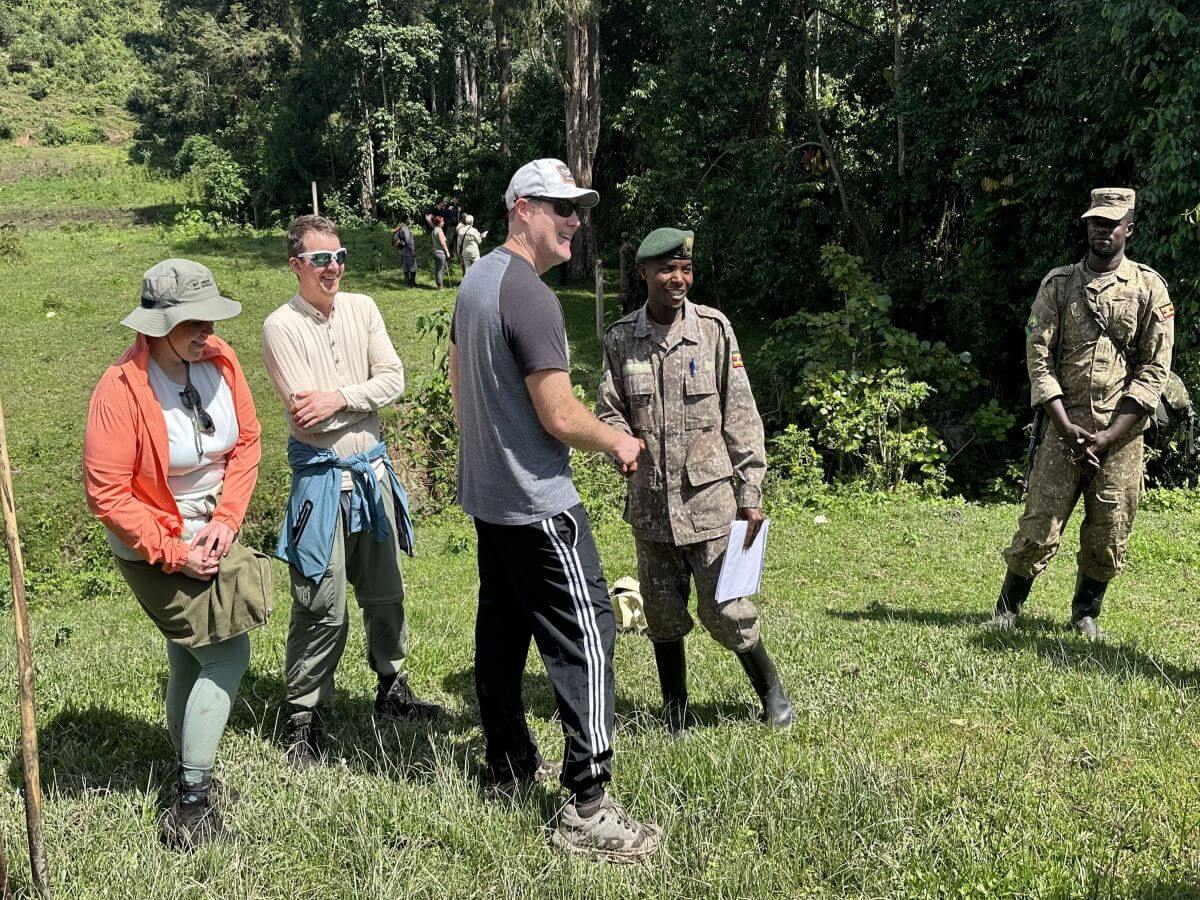Chimpanzee Tracking in the wild is like stepping into an adventure book. Picture yourself going deep into the heart of the jungle, surrounded by the lush greenery of the forest and the sounds of the untamed wilderness. Your mission? To track down one of our closest relatives in the animal kingdom, the chimpanzee.
Chimpanzee Tracking is like going on a treasure hunt. Guides lead you through the forest, teaching you to listen for sounds and spot signs of chimpanzee activity. As you move through the dense forests and winding trails, anticipation builds with each step. The thrill comes from not knowing when or where you might encounter them which keeps you on your toes.
And then, in the towering trees and with rays of sunlight seeping in through the canopy, you catch your first glimpse of the chimpanzees. For the next one hour, you will watch them going about their day. From playful juveniles swinging through the branches to wise elders surveying their domain, you will be able to see it all. It is a chance to witness the communication, social, and family dynamics of these primates.
This experience promises not only adventure but also a deep connection with nature’s wonders. But of course, with every great adventure, there are bound to be some challenges.
Chimpanzee tracking experiences are done with assistance from experienced guides. These guides are familiar with the habits and territories of the chimps which increases the likelihood of successful sightings. They lead the way, sharing their knowledge of chimp behavior and the surrounding environment.
They also ensure a safe and successful tracking experience which makes you comfortable enough to enjoy the experience.
Trails in the forests are marked so it is easy to know where you are going. In addition, the guides assigned to you also know where to look for the chimpanzees. This increases the chances of a successful encounter. Habituated chimpanzee communities are used to human presence and this makes sightings more likely and less disruptive.
Chimps are social animals, living in groups called troops. Tracking them often leads to sightings of not just one or two individuals, but entire families or communities. This provides excellent opportunities for observation and photography.
Chimpanzee Tracking isn’t a walk in the park. It involves hiking through thick forests and sometimes steep terrain. The trails can be challenging, requiring a reasonable level of fitness and agility from participants. It’s essential to be prepared for long walks and be comfortable with the physical demands of hiking in natural environments.
While the Chimpanzee Tracking guides are knowledgeable about chimpanzees’ behavior and their habitats, sightings are never guaranteed. Chimps move through the forest freely, and their whereabouts can be unpredictable. You may need to be patient and persistent, as success in tracking often requires time and luck.
The weather also affects the ease of chimp tracking. Rainy seasons may make trails muddy and slippery. The dense vegetation during the rainy season may also obstruct views during chimp tracking. It’s important to check weather forecasts and be prepared for the weather conditions that will be there on the day you’d like to go for Chimpanzee Tracking.

Chimpanzees live in the tropical forests of Africa and tracking them may require hiking for several hours. Make sure that you are physically fit before going for the trek. Doing regular exercises, including cardio and strength training, can help prepare your body for the Chimpanzee Tracking.
We recommend comfortable and sturdy hiking boots with good traction to help you navigate through uneven terrain. Lightweight, breathable clothing is also important, along with a hat and sunscreen for protection against the sun. Don’t forget insect repellent to keep away bugs.
You may also consider bringing essential items like a camera (with silent mode if possible) to capture the moments without disturbing the animals, binoculars for better viewing, and a small backpack to store your belongings.
Chimpanzee Tracking can be physically demanding and you’ll need to stay hydrated and energized throughout the journey. Bringing along plenty of water and high-energy snacks like nuts, granola bars, and fruits will help to keep energy levels up.
Listen carefully to the instructions provided by your guides before the trek begins. They will brief you on safety precautions, behavior around the chimpanzees, and what to expect during the trek. Following their guidance ensures a safe and enjoyable experience for everyone.
Remember that you are entering the chimpanzees’ natural habitat. Maintain a respectful distance from them and avoid making sudden movements or loud noises that could startle or disturb them. Observe quietly and follow your guide’s lead on how to interact with the chimpanzees.
Chimpanzee tracking is not always guaranteed to result in immediate sightings. Be prepared to spend several hours in the forest searching for them. Patience and persistence are key; sometimes, it’s the journey itself that’s most rewarding.
Weather conditions can change quickly, so be prepared with rain gear or extra layers. Also, be ready for the possibility of encountering other wildlife along the way.
Since you will be visiting tropical rainforests to these wild chimps, you should expect some rain at any time of the year. We advise that you visit during the dry season when the chances of rain are low and the rain will be a slight pour. During this season, you’re likely to have clearer skies and better visibility with higher chances of spotting chimpanzees, and the forest trails are less muddy and easier to navigate.
In East Africa, particularly Uganda, Rwanda, and Tanzania where chimpanzees are located, the dry season usually falls between June to August and December to February.
It is important to note that these weather patterns may vary so you should always check the weather forecast and plan accordingly.
